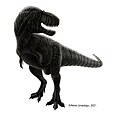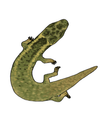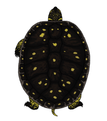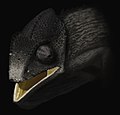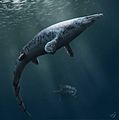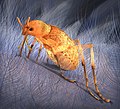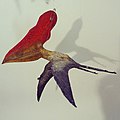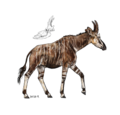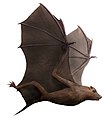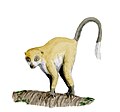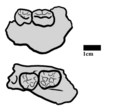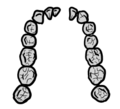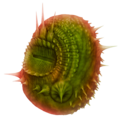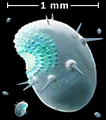Wikipedia:WikiProject Palaeontology/Paleoart review/Archive 28
| This is an archive of past discussions. Do not edit the contents of this page. If you wish to start a new discussion or revive an old one, please do so on the current talk page. |
| Archive 25 | Archive 26 | Archive 27 | Archive 28 |
Megapterygius wakayamaensis illustrations

Restoration based on Takuya Konishi, Masaaki Ohara, Akihiro Misaki, Hiroshige Matsuoka, Hallie P. Street & Michael W. Caldwell (2023) A new derived mosasaurine (Squamata: Mosasaurinae) from south-western Japan reveals unexpected postcranial diversity among hydropedal mosasaurs, Journal of Systematic Palaeontology, 21:1, DOI: 10.1080/14772019.2023.2277921 SeismicShrimp (talk) 21:42, 11 December 2023 (UTC)
- Should we really be giving mosasaurs extremely hypothetical dorsal fins that no one seem to have supported by any kind of research? FunkMonk (talk) 22:14, 11 December 2023 (UTC)
- I see it's in the paper, strange times... FunkMonk (talk) 22:18, 11 December 2023 (UTC)
- @FunkMonk, The paper does mention the possibility that geologic warping might have taken place, however the orientation of the neural spines appear more gradual along the dorsal region, so it seems to be more anatomical. I think its fine to include it with this specific genus, but until another paper is published finding support for dorsal fins in other genera, we should not edit other images. Also, may be a bit of a nitpick, but in most other mosasaur artwork, the upper part of the caudal fin is significantly smaller then the lower half, but here they are around equal lengths. Fossiladder13 (talk) 23:23, 11 December 2023 (UTC)
- Yeah, it's fine as long as it's suggested in the paper, but as we also discussed on Discord, it doesn't seem any studies on modern whales actually state that neural spine orientation correlates strongly with the presence of a dorsal fin... So it appears the authors are jumping the gun. FunkMonk (talk) 08:06, 12 December 2023 (UTC)
- @FunkMonk, yeah there are a number of cetaceans that have those raised spines, but don't have a dorsal fin at all (the finless porpoise is one example), so I think you might be right on the whole "jumping the gun" comment. And honestly, using mammals as a modern analogue to giant marine lizards feels a little odd, considering there are closer relatives to compare too. Fossiladder13 (talk) 15:42, 12 December 2023 (UTC)
- Yeah, it's fine as long as it's suggested in the paper, but as we also discussed on Discord, it doesn't seem any studies on modern whales actually state that neural spine orientation correlates strongly with the presence of a dorsal fin... So it appears the authors are jumping the gun. FunkMonk (talk) 08:06, 12 December 2023 (UTC)
- @FunkMonk, The paper does mention the possibility that geologic warping might have taken place, however the orientation of the neural spines appear more gradual along the dorsal region, so it seems to be more anatomical. I think its fine to include it with this specific genus, but until another paper is published finding support for dorsal fins in other genera, we should not edit other images. Also, may be a bit of a nitpick, but in most other mosasaur artwork, the upper part of the caudal fin is significantly smaller then the lower half, but here they are around equal lengths. Fossiladder13 (talk) 23:23, 11 December 2023 (UTC)
- I see it's in the paper, strange times... FunkMonk (talk) 22:18, 11 December 2023 (UTC)
- I would suggest that captions for this restoration should make it clear that Konishi et al.'s dorsal fin is speculative based on above discussion. To balance things out, maybe there's a way to point out the finless porpoise example without going WP:SYNTH? Macrophyseter | talk 22:15, 12 December 2023 (UTC)
Another two works needing review. Ta-tea-two-te-to (talk) 03:57, 13 December 2023 (UTC)
- Those forelimbs look broken on #1. It's not a plesiosaur! Lythronaxargestes (talk | contribs) 04:52, 13 December 2023 (UTC)
- Pinging the artists, @SpinoDragon145: and @ShamuBlackfish:. -SlvrHwk (talk) 05:54, 13 December 2023 (UTC)
- The humerus head is almost circular at top view which, if I'm correct, might suggest that range of motion is possible. But a more expert opinion on functional anatomy should weight on the exact dexterity of the limbs. Macrophyseter | talk
- Pinging the artists, @SpinoDragon145: and @ShamuBlackfish:. -SlvrHwk (talk) 05:54, 13 December 2023 (UTC)
- Snout for SpinoDragon's work is too longirostrine. Macrophyseter | talk 21:21, 13 December 2023 (UTC)
Megapterygius size comparison

Quick size chart for Megapterygius. Comments are appreciated, as always. -SlvrHwk (talk) 07:19, 13 December 2023 (UTC)
- I think 6m was meant for the total length estimate? Tail fin could also be bigger/wider or more crescent shaped; it doesn't seem very propulsive as is. Otherwise, looks good! Macrophyseter | talk 21:21, 13 December 2023 (UTC)
- Regarding the length, the arrow at the bottom doesn't mean anything in particular. I just don't usually have it fill the entire length of the image since sometimes that makes it harder to read. The size follows that shown in the press skeletal diagram and as indicated by the fossil material and close relatives. I can modify the tail fin when I get a minute. -SlvrHwk (talk) 21:43, 13 December 2023 (UTC)
- @Macrophyseter: I made some updates. Let me know if there's anything else I should fix. -SlvrHwk (talk) 00:58, 14 December 2023 (UTC)
- Looks good! Macrophyseter | talk 03:43, 18 December 2023 (UTC)
- @Macrophyseter: I made some updates. Let me know if there's anything else I should fix. -SlvrHwk (talk) 00:58, 14 December 2023 (UTC)
- Regarding the length, the arrow at the bottom doesn't mean anything in particular. I just don't usually have it fill the entire length of the image since sometimes that makes it harder to read. The size follows that shown in the press skeletal diagram and as indicated by the fossil material and close relatives. I can modify the tail fin when I get a minute. -SlvrHwk (talk) 21:43, 13 December 2023 (UTC)
- I think 6m was meant for the total length estimate? Tail fin could also be bigger/wider or more crescent shaped; it doesn't seem very propulsive as is. Otherwise, looks good! Macrophyseter | talk 21:21, 13 December 2023 (UTC)

Due to the recent description of Mobulavermis, it seems that Kerygmachela, and it’s close relatives, actually lack the lobopod-type limbs that were present beforehand. The restoration of Mobulavermis doesn’t have the lobopods, and Utahnax doesn’t have a restoration at all, so this seems to be the only one that needs to be fixed. Fossiladder13 (talk) 23:39, 13 December 2023 (UTC)
- I see. I'll keep this one as an alternative interpretation, while provide another version without the lobopods visible (like the Opabinia I made before 1 2). Junnn11 (talk) 05:28, 14 December 2023 (UTC)
- Lack of lobopods was already mentioned when Utahnax was described. And yeah alternative interpretation image is best solution I agree. Ta-tea-two-te-to (talk) 09:06, 14 December 2023 (UTC)
- Looks like a new version[1] was added to the article, but remember to post for review first, PaleoEquii.FunkMonk (talk) 23:07, 18 December 2023 (UTC)
- I didn't post it for review here because it's literally the reconstruction published in my paper. PaleoEquii (talk) 23:36, 18 December 2023 (UTC)
- Yeah, I think the peer review the image got there was probably enough. Congrats on the paper by the way. Hemiauchenia (talk) 23:38, 18 December 2023 (UTC)
- I didn't post it for review here because it's literally the reconstruction published in my paper. PaleoEquii (talk) 23:36, 18 December 2023 (UTC)

I finished this illustration in early October, but kept forgetting to upload it... anyways, here it is now, life restoration Stenopterygius triscissus, often overshadowed by its more famous (and spectacular) relative S. quadrisciscissus. S. triscissus is nevertheless still known from a multitude of good material, and I referred to S. quadriscissus and S. sp. for the soft tissue and coloration. Comments most welcome. --Slate Weasel [Talk - Contribs] 16:32, 15 December 2023 (UTC)
- Looks nice, but it’s quite difficult to see the dark animal on the black background. -SlvrHwk (talk) 17:46, 15 December 2023 (UTC)
- Hm... the black backgrounds are kind of my standard, but I do understand the concern. I could try to make the background white, if that would be desirable (though it may make the coloration appear somewhat messier, given how I colored it). --Slate Weasel [Talk - Contribs] 00:03, 16 December 2023 (UTC)
- Probably also worth pointing out that images are more useful in for example cladograms and other things if they have white or transparent backgrounds... FunkMonk (talk) 22:22, 18 December 2023 (UTC)
- I'll look into erasing the background tomorrow... I figure transparency is probably the most useful solution here (and not without precedent...) --Slate Weasel [Talk - Contribs] 22:34, 18 December 2023 (UTC)
- Background removed. --Slate Weasel [Talk - Contribs] 23:14, 19 December 2023 (UTC)
- I'll look into erasing the background tomorrow... I figure transparency is probably the most useful solution here (and not without precedent...) --Slate Weasel [Talk - Contribs] 22:34, 18 December 2023 (UTC)
- Probably also worth pointing out that images are more useful in for example cladograms and other things if they have white or transparent backgrounds... FunkMonk (talk) 22:22, 18 December 2023 (UTC)
- Hm... the black backgrounds are kind of my standard, but I do understand the concern. I could try to make the background white, if that would be desirable (though it may make the coloration appear somewhat messier, given how I colored it). --Slate Weasel [Talk - Contribs] 00:03, 16 December 2023 (UTC)
Quasicaecilia
Hello again. Sorry for bothering again, but can I ask for another review? This time it is another microsaur (sorry..) which is Quasicaecilia. I restored the head based on this paper [2] but I made the front part a bit thicker and wide since it is said to be a fossorial animal that is similar to amphibaenia? So I assumed it should have a extra thickness in the front part to shovel around the soil.. Next, for the body, I made it to look similar to its close relatives like Batropetes. Lastly for the scalation, I used the paper that I have been using for the reference for my other microsaurs reconstruction [3] But for the head dorsal scalation, I admit it is mostly a speculation based on the skull ornamentation, comparing with modern day fossorial lizard, and looking at Gabriel Ugueto's version of this animal
I guess that is for the reconstruction reasoning. Is my reconstruction good enough to be used for Quasicaecilia page? Thank you in advance as always...

DD (talk) 13:04, 14 December 2023 (UTC)
- It seems there are no major revision for this image? I will upload it into the Quasicaecilia page then. But as always, if there are any glaring inaccuracies spotted when the image have been uploaded, please just take it down.. Thank you... DD (talk) 10:24, 21 December 2023 (UTC)
Planocephalosaurus

Based on [4] and the various copies that have been published in other research paper since. Hemiauchenia (talk) 22:39, 21 December 2023 (UTC)
Planocephalosaurus life restoration
Restoration based on the paper "The postcranial skeleton of the upper Triassic Sphenodontid Planocephalosaurus robinsonae"

. — Preceding unsigned comment added by SeismicShrimp (talk • contribs) .
- Looks good to me. @NGPezz: has had his feedback already incorporated, so I assume it's good with him too. Hemiauchenia (talk) 01:29, 24 December 2023 (UTC)
Assorted unreviewed palaeoart from Commons
There is now so much unreviewed palaeoart on Commons that it doesn't make sense to put it for review piece by piece or artist by artist, so here I've compiled a lot of what I could find, and will add more as I find it, and anyone is welcome to add more, as it's important we get them approved before use, and the backlog is pretty big. Better to tag as much as inaccurate as we can than let it float around on Commons for unsuspecting users to add to articles. FunkMonk (talk) 19:07, 14 September 2023 (UTC)
-
Mosasaur egg
-
Miocene Bufonid
-
Bretesuchus
-
Notosuchus terrestris
-
Achanarella (used in Jamoytiiformes)
-
Looks like this user
-
did not know how to
-
upload new version of image...
-
Rhinella loba (looks like posted by researcher but not sure art author would be themselves or not)
-
Moanasaurus
-
Archaeopteryx
-
Allosaurus by same artist, shrinkwrapped
- I am not sure about the lack of a tail fluke and missing fin trailing edges on the Kimmerosaurus (all three, I suppose). Lythronaxargestes (talk | contribs) 19:11, 14 September 2023 (UTC)
- The Mingau images were reviewed before, though I don't think much came of it: [5] Lythronaxargestes (talk | contribs) 19:33, 14 September 2023 (UTC)
- Given that Homo luzonensis is only known from like, finger bones, the life restoration is essentially useless. Hemiauchenia (talk) 19:38, 14 September 2023 (UTC)
- It's known from digits and a handful of teeth, yeah. This species is probably an Indonesian erectus offshoot, which it conveys well enough, but still I'd agree that it's far too speculative for WP. Clumsystiggy (talk) 20:16, 14 September 2023 (UTC)
- Someone should double check but I do believe to recall that the tusks of Rytiodus would not have been exposed like that. More concretely, Erpetosuchus appears to have a basal archosaur ear, but also crocodilian ear flaps? Armin Reindl (talk) 20:09, 14 September 2023 (UTC)
- Could be painted out if that's the case. FunkMonk (talk) 20:49, 14 September 2023 (UTC)
- All other restorations I can find of Rytiodus also seem to show the tusks exposed? FunkMonk (talk) 14:54, 16 September 2023 (UTC)
- Armin Reindl, so if I wanted to fix the Erpetosuchus, I would just have to paint out the ear flaps? And why is the ear opening so far down the neck? And the antorbital fenestra should probably not be so visible. FunkMonk (talk) 14:24, 17 September 2023 (UTC)
- I removed the weird neck-ear, Armin Reindl. FunkMonk (talk) 17:20, 5 October 2023 (UTC)
- Armin Reindl, so if I wanted to fix the Erpetosuchus, I would just have to paint out the ear flaps? And why is the ear opening so far down the neck? And the antorbital fenestra should probably not be so visible. FunkMonk (talk) 14:24, 17 September 2023 (UTC)
- All other restorations I can find of Rytiodus also seem to show the tusks exposed? FunkMonk (talk) 14:54, 16 September 2023 (UTC)
- Could be painted out if that's the case. FunkMonk (talk) 20:49, 14 September 2023 (UTC)
- That Diademodon doesn't even look like a cynodont, it looks more like an entelodont. Lythronaxargestes (talk | contribs) 20:37, 14 September 2023 (UTC)
- Is the Cryolophosaurus a little to speculative for Wikipedia?. Like I’m sure the animal has some form of feathering, but is the amount shown here a little much?. Fossiladder13 (talk) 01:28, 15 September 2023 (UTC)
- Also why is there a faint pair of legs in the background of the image. Looks like an earlier attempt?. Fossiladder13 (talk) 01:30, 15 September 2023 (UTC)
- Uhhh, why is Crocutacrocutaspelaea.png portraying inconsistent Crocuta snout sizes? It's literally just a subspecies of the spotted hyena, so it's odd seeing the one on the left having such a short snout, hyaenids never had such traits. PrimalMustelid (talk) 18:02, 15 September 2023 (UTC)
- Yeah, looks more like a gnoll, I'll tag it... FunkMonk (talk) 19:45, 15 September 2023 (UTC)
- Added some more mainly mammals if you want to have a look, PrimalMustelid, by Juandertal, who I'll friendly remind to add images for review, no matter how good they look! Will also remind Mariomassone in this regard, who has some unreciewed mammals above. FunkMonk (talk) 15:49, 16 September 2023 (UTC)
- I personally wouldn't mind if mine were just deleted. They're an embarassment. Mariomassone (talk) 16:01, 16 September 2023 (UTC)
- Ah, that's maybe a bit harsh, I like the Canis restorations, and either way, they can work as good placeholders until something else is found? FunkMonk (talk) 16:11, 16 September 2023 (UTC)
- Don`t, as long as there are no anatomical mistakes and the artstyle doesnt distort the appearance of the animal, they are good for visualizing extinct species. Also, nobody starts out as a master, you will get better.
- And sorry for using my images in pages without posting them here, Ill make sure to do it from now on. Juandertal (talk) 17:19, 18 September 2023 (UTC)
- I personally wouldn't mind if mine were just deleted. They're an embarassment. Mariomassone (talk) 16:01, 16 September 2023 (UTC)
- Added some more mainly mammals if you want to have a look, PrimalMustelid, by Juandertal, who I'll friendly remind to add images for review, no matter how good they look! Will also remind Mariomassone in this regard, who has some unreciewed mammals above. FunkMonk (talk) 15:49, 16 September 2023 (UTC)
- Yeah, looks more like a gnoll, I'll tag it... FunkMonk (talk) 19:45, 15 September 2023 (UTC)
- "Vitakridrinda" is...quite something. Probably unusable. This shouldn't be too much of an issue though, since it's an informal Malkani taxon. -SlvrHwk (talk) 02:13, 17 September 2023 (UTC)
- Can be tagged as too speculative. That Thalassodromeus you added also looks way too large, and the hands and feet are very strange. FunkMonk (talk) 11:41, 17 September 2023 (UTC)
- I find it hard to pinpoint why, but I'm not a fan of any of the three felid pictures. The easiest to note is that Panthera atrox, the American lion, is now thought to have been reddish; also in that same picture the snout/nose look wrong- the nose looks a little snubbed and upturned. As for the Smilodons, well, the changing image changes to fast for me to focus on the details, which is a different kind of annoying, while in the painting it looks like the front half of the body is disconnected from the back half. Moreover, the neck looks too fat around and the foreleg and paw that are visible look a little large. SilverTiger12 (talk) 18:32, 18 September 2023 (UTC)
- Added Pseudopulex, although it somewhat looks like press-art or something, it looks like having much different proportion compared to actual fossils? Ta-tea-two-te-to (talk) 01:13, 19 September 2023 (UTC)
- Eyeballing it, the Shonisaurus seems to have too short fins ([6]). Additionally, the very broad hindfin depicted does not match with what is known for this taxon. --Slate Weasel [Talk - Contribs] 16:43, 22 September 2023 (UTC)
- the "cretolamna" and "carcharocles" megalodon should not be used as they do not match up with living lamniformes and what we know of otodontid anatomy as they both have lower lips ,the megalodon does not have an anal fin, and the general proportions are off on every count EvolutionIncarnate (talk) 20:58, 29 September 2023 (UTC)
- Added three reconstructions by Marcio L. Castro, whose works previously reviewed as well. Ta-tea-two-te-to (talk) 06:00, 30 September 2023 (UTC)
- Also added some arts by Rom-diz, probably today's Roman Uchytel, it is only used in some old pages but what are problems? Ta-tea-two-te-to (talk) 07:22, 1 October 2023 (UTC)
- I will do separated discussion about Spheniscus, looks like it is worth to discuss in that. Ta-tea-two-te-to (talk) 08:23, 14 November 2023 (UTC)
- I tagged the two latest Archaeopteryx as having inaccurate wing-plumage. FunkMonk (talk) 09:41, 14 November 2023 (UTC)
- I found Jianchangornis which wing looks too simple? Ta-tea-two-te-to (talk) 02:47, 20 December 2023 (UTC)
- This Puentemys is clearly trace of Satoshi Kawasaki[7] so I nominated it copyvio. Ta-tea-two-te-to (talk) 03:10, 24 December 2023 (UTC)
Tuatara skull diagram

Is this even within the scope of this page? I'm posting it here anyway. Based on a 16 year old image by Nobu Tamura [8], labelling and modifications after this 3D atlas and this 2008 paper. Hemiauchenia (talk) 23:08, 24 December 2023 (UTC)
Petrodactyle size comparison

I started this shortly after the description was published, but never got around to uploading it. Commenters on the Discord server did not reach an agreement on the best shape of the head crest based on these options. A is a conservative approach with minimal addition (maybe the best for Wiki purposes?), while C is based on a life restoration by one of the authors. B is somewhere in between. Furthermore, comments were made regarding the posture of the hands based on fossil trackways. The version shown here is an approximation of how that might look, but it's hard to get the correct angle shown in a side-view. Any thoughts on these issues? -SlvrHwk (talk) 21:50, 13 December 2023 (UTC)
- There's not really a solid bracket for this but I think B could be a reasonable extrapolation from soft tissue crest morphology in other pterosaurs. Lythronaxargestes (talk | contribs) 05:07, 14 December 2023 (UTC)
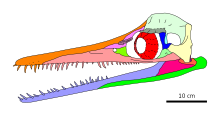
Put this together using the skull diagram(s) and fossils of Unktaheela described in the new Dolichorhynchops revision paper [9]. Comments appreciated. -SlvrHwk (talk) 10:04, 25 December 2023 (UTC)
Images by NT and DB
Nobu Tamura
NT and DB have both contributed about a gazillion restorations on Commons, a very large percentage of which have never been reviewed. So I've added the first ones I could find and some I've already edited, but there are tonnes more, so feel free to add. The task will be too large for any single mortal being. Hopefully we can get an end to these unreviewed images floating around, and as these editors are largely inactive now, it might actually be possible. FunkMonk (talk) 17:41, 3 October 2023 (UTC)
-
2014 in paleontology
-
2013 in paleontology
-
2017 in paleontology
- For starters, the Ornithocheirus here seems off in multiple ways, including but not limited to wing shape and overall proportions. The Morrison Man (talk) 18:44, 3 October 2023 (UTC)
- Since we're unlikely to get another restoration of it, I'm inclined to modify it so it can be saved. Know of any good reference skeletals? FunkMonk (talk) 19:13, 3 October 2023 (UTC)
- The only decent one I know of is this one by Sassy Paleonerd. I'm afraid our known material of Ornithocheirus proper is quite unimpressive though. The Morrison Man (talk) 19:21, 3 October 2023 (UTC)
- Yeah, a skeletal of a relative would probably do, but can't find one in the right view. But perhaps something like this:[10] So I'm thinking smaller body, narrower wings, rounder wing-tips? FunkMonk (talk) 19:28, 3 October 2023 (UTC)
- Sounds good! Smaller body in proportion to wings & head i assume? As an aside, we might honestly want to consider requesting a new illustration. The Morrison Man (talk) 21:14, 3 October 2023 (UTC)
- With the gigantic amount of images that don't have alternatives, our huge backlog of unillustrated genera, and the fact that this one is barely known from anything, I think the most realistic approach is just to fix what can be fixed of what we already have, as these images are already spread far and wide across pages and Wikipedias. And there are many higher priorities when it comes to new restorations. FunkMonk (talk) 23:03, 3 October 2023 (UTC)
- Sounds good! Smaller body in proportion to wings & head i assume? As an aside, we might honestly want to consider requesting a new illustration. The Morrison Man (talk) 21:14, 3 October 2023 (UTC)
- Yeah, a skeletal of a relative would probably do, but can't find one in the right view. But perhaps something like this:[10] So I'm thinking smaller body, narrower wings, rounder wing-tips? FunkMonk (talk) 19:28, 3 October 2023 (UTC)
- The only decent one I know of is this one by Sassy Paleonerd. I'm afraid our known material of Ornithocheirus proper is quite unimpressive though. The Morrison Man (talk) 19:21, 3 October 2023 (UTC)
- Since we're unlikely to get another restoration of it, I'm inclined to modify it so it can be saved. Know of any good reference skeletals? FunkMonk (talk) 19:13, 3 October 2023 (UTC)
- The Dinogorgon looks pretty lanky and shrink wrapped for a gorgonopsian. Fossiladder13 (talk) 22:15, 3 October 2023 (UTC)
Thoughts on some of the marine reptiles:
- The Ophthalmosaurus has a really weirdly-shaped head, it doesn't look like the skull would fit inside it. Additionally, the forefins should be significantly (i.e. >2x) larger than the hindfins, whereas they seem fairly similar in size in the drawing. (Skeletals of Ophthalmosaurus by Hartman [11] and Zverkov Fig. 19 for comparison)
- The Platecarpus has a very shrinkwrapped skull and limbs, and is lacking a tail bend (See [12] for comparison)
- The Clidastes are not only very shrinkwrapped, they seem too skinny for the skeleton to actually fit inside, particularly in the thorax and tail. The limbs also look long and narrow, whereas the limbs of Clidastes are short and broad. (See Williston's skeletal reconstruction for comparison.
Since we have much less problematic life restorations of all three of these, I will go ahead and tag these as inaccurate on Commons. I've not yet taken a close look at the other marine reptiles but may do so in the future. --Slate Weasel [Talk - Contribs] 21:01, 7 October 2023 (UTC)
- The Atychodracon seems to have too large a head, and it doesn't appear to have the correct shape: it should be more triangular, and bear a fairly prominent constriction. The teeth should also extend back behind the eyes, and seem to have been drawn curiously small [13][14]. The forelimbs may also be lacking in flesh. --Slate Weasel [Talk - Contribs] 21:57, 27 October 2023 (UTC)
- The Gallardosaurus seems to have quite a small head for a thalassophonean, and the very short, skinny neck doesn't seem plausible for a thalassophonean, which would have been rather streamlined. Not entirely sure but the eye might also be a bit far forwards as well. --Slate Weasel [Talk - Contribs] 00:03, 9 December 2023 (UTC)
- The Muraenosaurus might be drawn at an angle, which could be throwing off my interpretation of it. However, the head looks too large, the body too short and rotund, the tail too long and skinny, and the hindfins seem too lack flesh (compare Andrews' skeletal, as seen here: [16]). I'm also not sure if the bright, almost neon blue is especially plausible for a color scheme. --Slate Weasel [Talk - Contribs] 17:09, 9 December 2023 (UTC)
- I've tried to fix the issues you pointed out with the Muraenosaurus, but I think the Gallardosaurus may be too wonky and 3D to fix easily (the skeletal diagram should definitely be placed in the taxobox). FunkMonk (talk) 22:58, 18 December 2023 (UTC)
- The Muraenosaurus looks better, but it still has serious proportional issues (the most glaring of which is that the neck and trunk should be of roughly equal length). Honestly, I'm not sure if it's worth it trying to save this one, considering that we have another Muraenosaurus by Dino Dan ([17]) that looks pretty spot-on, which we could use instead. --Slate Weasel [Talk - Contribs] 17:42, 19 December 2023 (UTC)
- But like with most other such older images, look at the wide usage; that alone is reason to correct it, and shouldn't be too hard. I'll shorten the neck. FunkMonk (talk) 23:53, 19 December 2023 (UTC)
- I made it closer to Dan's. So now we at least won't have to worry about when it inevitably gets used on some non-English Wikipedias and so on (which is a reason to fix images even when new versions are made). FunkMonk (talk) 19:48, 26 December 2023 (UTC)
- Looks much better, my only complaint now would be that the flippers look a bit too big, but then again we don't know just how extensive the soft tissue on the flippers of Muraenosaurus would have been (and if Mauriciosaurus is anything to go by, it probably could have been quite extensive, quite possibly enough to make them as big as they appear here). --Slate Weasel [Talk - Contribs] 22:11, 27 December 2023 (UTC)
- Alright, and speaking of Mauriciosaurus, I gave NT's restoration a tail-fluke too... FunkMonk (talk) 00:41, 28 December 2023 (UTC)
- I'm... not sure I would have done that. Polycotylids have particularly stubby tails among plesiosaurs and given the mass of soft tissue surrounding the tail of Mauriciosaurus in particular I don't think a tail fluke is particularly well-justified. At least a slight distal expansion as in File:Dolichorhynchops osborni.png would feel more likely. Lythronaxargestes (talk | contribs) 02:34, 28 December 2023 (UTC)
- Oh, but is there any particular evidence for that? Dinodan's other polycotylids seem to vary between having full-blown tail flukes and more of a small expansion, see cladogram images at Martinectes. The one I added[18] doesn't seem much larger than the ones he depicted on the more derived members. FunkMonk (talk) 03:23, 28 December 2023 (UTC)
- More so the lack of osteological correlates. It doesn't have the pygostyle seen in other cryptoclidians. If there was one, I can't see it being much more than vestigial. Lythronaxargestes (talk | contribs) 03:57, 28 December 2023 (UTC)
- But couldn't that be said for most other plesiosaurs? The only one where we have concrete evidence, Seeleyosaurus, doesn't seem to have osteological correlates. FunkMonk (talk) 04:49, 28 December 2023 (UTC)
- Seeleyosaurus has fused distal caudal neural arches. Lythronaxargestes (talk | contribs) 07:01, 28 December 2023 (UTC)
- The tail tip of Mauriciosaurus seems to be missing, and there doesn't seem to be soft tissue preserved there, so I'm not sure if we can rule out a tail fin in that taxon. Furthermore, Polycotylus itself has a pygostyle. --Slate Weasel [Talk - Contribs] 12:22, 28 December 2023 (UTC)
- You're right - I stand corrected. Lythronaxargestes (talk | contribs) 15:08, 28 December 2023 (UTC)
- All plesiosaurs seem to be restored with some sort of fluke these days, and older ones are tagged as inaccurate when they don't have them... I don't think I've seen any modern plesiosaur palaeoart without some sort of tail expansion? FunkMonk (talk) 13:41, 28 December 2023 (UTC)
- The tail tip of Mauriciosaurus seems to be missing, and there doesn't seem to be soft tissue preserved there, so I'm not sure if we can rule out a tail fin in that taxon. Furthermore, Polycotylus itself has a pygostyle. --Slate Weasel [Talk - Contribs] 12:22, 28 December 2023 (UTC)
- Seeleyosaurus has fused distal caudal neural arches. Lythronaxargestes (talk | contribs) 07:01, 28 December 2023 (UTC)
- But couldn't that be said for most other plesiosaurs? The only one where we have concrete evidence, Seeleyosaurus, doesn't seem to have osteological correlates. FunkMonk (talk) 04:49, 28 December 2023 (UTC)
- More so the lack of osteological correlates. It doesn't have the pygostyle seen in other cryptoclidians. If there was one, I can't see it being much more than vestigial. Lythronaxargestes (talk | contribs) 03:57, 28 December 2023 (UTC)
- Oh, but is there any particular evidence for that? Dinodan's other polycotylids seem to vary between having full-blown tail flukes and more of a small expansion, see cladogram images at Martinectes. The one I added[18] doesn't seem much larger than the ones he depicted on the more derived members. FunkMonk (talk) 03:23, 28 December 2023 (UTC)
- I'm... not sure I would have done that. Polycotylids have particularly stubby tails among plesiosaurs and given the mass of soft tissue surrounding the tail of Mauriciosaurus in particular I don't think a tail fluke is particularly well-justified. At least a slight distal expansion as in File:Dolichorhynchops osborni.png would feel more likely. Lythronaxargestes (talk | contribs) 02:34, 28 December 2023 (UTC)
- Alright, and speaking of Mauriciosaurus, I gave NT's restoration a tail-fluke too... FunkMonk (talk) 00:41, 28 December 2023 (UTC)
- Looks much better, my only complaint now would be that the flippers look a bit too big, but then again we don't know just how extensive the soft tissue on the flippers of Muraenosaurus would have been (and if Mauriciosaurus is anything to go by, it probably could have been quite extensive, quite possibly enough to make them as big as they appear here). --Slate Weasel [Talk - Contribs] 22:11, 27 December 2023 (UTC)
- I made it closer to Dan's. So now we at least won't have to worry about when it inevitably gets used on some non-English Wikipedias and so on (which is a reason to fix images even when new versions are made). FunkMonk (talk) 19:48, 26 December 2023 (UTC)
- But like with most other such older images, look at the wide usage; that alone is reason to correct it, and shouldn't be too hard. I'll shorten the neck. FunkMonk (talk) 23:53, 19 December 2023 (UTC)
- The Muraenosaurus looks better, but it still has serious proportional issues (the most glaring of which is that the neck and trunk should be of roughly equal length). Honestly, I'm not sure if it's worth it trying to save this one, considering that we have another Muraenosaurus by Dino Dan ([17]) that looks pretty spot-on, which we could use instead. --Slate Weasel [Talk - Contribs] 17:42, 19 December 2023 (UTC)
- I've tried to fix the issues you pointed out with the Muraenosaurus, but I think the Gallardosaurus may be too wonky and 3D to fix easily (the skeletal diagram should definitely be placed in the taxobox). FunkMonk (talk) 22:58, 18 December 2023 (UTC)
Dmitry Bogdanov
- Perhaps a bit minor, but the teeth on the Elasmosaurus look off compared to other elasmosaurines, such as Styxosaurus and Terminonatator ([19], File:Styxosaurus snowii skull diagram.jpg, File:Styxosaurus browni skull diagram.jpg; Nakonanectes, Thalassomedon and Libonectes seem to show this too) in which the teeth in both jaws extend posterior to the eye, and vary regionally in size (large in front, small in back in the upper jaw; largest in front, small in middle, medium in back in the lower jaw). Also, has it been proposed that Prognathodon waiparaensis would have had extremely croc-like jaws like that? If not, it should probably be given lips. --Slate Weasel [Talk - Contribs] 17:09, 7 October 2023 (UTC)
- The Elasmosaurus has been replaced in the article, so could be tagged. As for the Prognathodon, it's from 2008, when it seems every prehistoric reptile was depicted without lips for some reason. I can probably fix that. FunkMonk (talk) 16:44, 9 October 2023 (UTC)
- FunkMonk, another thought on Prognathodon: they all (including Dollosaurus, which is pretty well-substantiated as a jr. syn) seem to have very minimal tissues in their fins, particularly P. waiparaensis. This is probably not realistic based on a specimen attributed to Prognathodon preserving the outline of the fins: [20]; I probably should have mentioned that earlier, before you added the lips, but it slipped my mind. --Slate Weasel [Talk - Contribs] 16:57, 27 October 2023 (UTC)
- They should be easy enough to fix, I also noticed some of them don't have completely white backgrounds, so I'll fix that at the same time. FunkMonk (talk) 22:58, 14 November 2023 (UTC)
- Slate Weasel, I've tried to fix the Prognathodon fins. I wonder if the rest of DB's mosasaurs need a similar treatment? FunkMonk (talk) 00:30, 25 November 2023 (UTC)
- The new fins look nice; not sure how much we can extrapolate with this to other mosasaurs but his Mosasaurus beaugei looks like it could definitely use more flesh on its limbs (giving a mosasaurin partially separate digits is probably about as probable as doing so for a mixosaurid). --Slate Weasel [Talk - Contribs] 20:23, 25 November 2023 (UTC)
- I'll see what I can do. In the meantime, I noticed that the Halisaurus has odd claws coming out of its fins, is that likely at all, Slate Weasel? FunkMonk (talk) 14:05, 3 December 2023 (UTC)
- FunkMonk, I'm not really sure; though for what it's worth I do see that the description paper of Eonatator/Halisaurus coellensis does state: "Las falanges ungulares conservadas son de extremidad aguda y ligeramente recurvadas" (which, using Google Translate, I think means roughly, "The preserved ungual phalanges are sharp and slightly recurved"). --Slate Weasel [Talk - Contribs] 19:27, 3 December 2023 (UTC)
- I'll see what I can do. In the meantime, I noticed that the Halisaurus has odd claws coming out of its fins, is that likely at all, Slate Weasel? FunkMonk (talk) 14:05, 3 December 2023 (UTC)
- The new fins look nice; not sure how much we can extrapolate with this to other mosasaurs but his Mosasaurus beaugei looks like it could definitely use more flesh on its limbs (giving a mosasaurin partially separate digits is probably about as probable as doing so for a mixosaurid). --Slate Weasel [Talk - Contribs] 20:23, 25 November 2023 (UTC)
- Slate Weasel, I've tried to fix the Prognathodon fins. I wonder if the rest of DB's mosasaurs need a similar treatment? FunkMonk (talk) 00:30, 25 November 2023 (UTC)
- They should be easy enough to fix, I also noticed some of them don't have completely white backgrounds, so I'll fix that at the same time. FunkMonk (talk) 22:58, 14 November 2023 (UTC)
- FunkMonk, another thought on Prognathodon: they all (including Dollosaurus, which is pretty well-substantiated as a jr. syn) seem to have very minimal tissues in their fins, particularly P. waiparaensis. This is probably not realistic based on a specimen attributed to Prognathodon preserving the outline of the fins: [20]; I probably should have mentioned that earlier, before you added the lips, but it slipped my mind. --Slate Weasel [Talk - Contribs] 16:57, 27 October 2023 (UTC)
- The Elasmosaurus has been replaced in the article, so could be tagged. As for the Prognathodon, it's from 2008, when it seems every prehistoric reptile was depicted without lips for some reason. I can probably fix that. FunkMonk (talk) 16:44, 9 October 2023 (UTC)
- The Pervushovisaurus, if it really is supposed to be P. campylodon (its taxonomy is such a mess), seems to have too short a snout (compare File:Pervushovisaurus campylodon rostra.png, [21]), even compared to Platypterygius australis, which seems to have a shorter, deeper snout than Pervushovisaurus. A second orifice in the narial region should probably be added as well, given that the nares of platypterygiines are commonly bifurcated. Not sure if the orbital region should be so much deeper than the snout either. The extremely narrow hindfin of the individual in the foreground seems unlikely given the extensive soft tissue extensions seen in the hindfin of Aegirosaurus (and moreso with Stenopterygius and Hauffiopteryx). Additionally, the way the upper jaw seems to overhang the lower (as in, the lower jaw inserts into the upper and is partially hidden in side view) is inaccurate for pretty much ichthyosaurs in general, and the lack of lips seems improbable. --Slate Weasel [Talk - Contribs] 13:49, 28 October 2023 (UTC)
- Not sure if I'm able to fix all this given my lack of experience with ichthyosaurs, but what indicates ichthyosaurs would have had lips? Even some river dolphins have exposed teeth. FunkMonk (talk) 20:28, 31 October 2023 (UTC)
- The Platanista dolphins are very much the exception, not the rule (i.e., how we would depict parvipelvian ichthyosaurs with dorsal fins even when there's no evidence either way, due to parsimony, despite some cetaceans having lost their dorsal fins). To my knowledge I don't think anything has been published on ichthyosaur lips, but one thing I've noticed is that ichthyosaur teeth very rarely overlap the jaw bones very much, as seen in the fossils of Pervushovisaurus campylodon, differing from the more extensive overlapping often seen in crocodilians and plesiosaurs, which are generally considered lipless. I'm not sure whether this is definitive evidence of lips, but at the very least it indicates that the jaws would look markedly different without lips from how they are restored here. (sorry about my very late reply here) --Slate Weasel [Talk - Contribs] 16:00, 10 November 2023 (UTC)
- It could maybe be used as a "most likely" scenario, but I'm not sure it's strong enough to remove or tag images on that basis (especially, as you say, nothing seems to have been published on it). But I guess it's moot in some of these cases, where there's so much other stuff wrong. FunkMonk (talk) 02:08, 11 November 2023 (UTC)
- The Platanista dolphins are very much the exception, not the rule (i.e., how we would depict parvipelvian ichthyosaurs with dorsal fins even when there's no evidence either way, due to parsimony, despite some cetaceans having lost their dorsal fins). To my knowledge I don't think anything has been published on ichthyosaur lips, but one thing I've noticed is that ichthyosaur teeth very rarely overlap the jaw bones very much, as seen in the fossils of Pervushovisaurus campylodon, differing from the more extensive overlapping often seen in crocodilians and plesiosaurs, which are generally considered lipless. I'm not sure whether this is definitive evidence of lips, but at the very least it indicates that the jaws would look markedly different without lips from how they are restored here. (sorry about my very late reply here) --Slate Weasel [Talk - Contribs] 16:00, 10 November 2023 (UTC)
- Not sure if I'm able to fix all this given my lack of experience with ichthyosaurs, but what indicates ichthyosaurs would have had lips? Even some river dolphins have exposed teeth. FunkMonk (talk) 20:28, 31 October 2023 (UTC)


- As pointed out on Discord by @SeismicShrimp:, Nobu Tamuras Lazarussuchus restoration has a crest on the neck, when the soft tissue shows that a crest was only present over the tail. This could maybe be photoshopped out. The 2007 restoration of the skull of the tuatara has an obvious anatomical error. The pineal/parietal foramen (the hole in the top of the skull), is enclosed within the frontal bones, when in actual specimens of the tuatara they are enclosed within the parietal bones, as can be seen in this coloured 3D skull scan [22] (the model can be rotated when the animation is paused). Again, I think this could be fixed with image editing. Hemiauchenia (talk) 22:44, 27 December 2023 (UTC)
- Removed the neck crest, which was the easier edit, I'll have to return to that skull... FunkMonk (talk) 00:41, 28 December 2023 (UTC)
- @Hemiauchenia:, after overlaying that skull scan on NT's tuatara drawing it looks like it's radically different in the relative proportions of everything, so I think it's best just to tag it and its derivatives as inaccurate and use one of the actual skull photos we have:[23] FunkMonk (talk) 19:34, 30 December 2023 (UTC)
- Removed the neck crest, which was the easier edit, I'll have to return to that skull... FunkMonk (talk) 00:41, 28 December 2023 (UTC)

After reading "A new insight into pycnodontiform fishes",[24] it looks like Coelodus, which only C. saturnus is valid, have somewhat long body. So @El fosilmaníaco:, I think Coelodus descripted here is wrong. While it is from Slovenia it should show C. saturnus so it should be based on that. This document[25] looks like have multiple picutures of C. saturnus although I am not sure how many of these are actually belongs to that, but one labelled "Pycnodus saturnus" is drawing of holotype specimen. Ta-tea-two-te-to (talk) 05:45, 21 November 2023 (UTC)
- Hi, apologies for the delay and thanks for the mention! You are right, the fish should be changed to better fit Coelodus saturnus appearance. I probably based my depiction in the photo previously present in the genus page. I may not be able to correct this in the following weeks, but I plan to do so when available. Also, thanks for providing reference photos! El fosilmaníaco (talk) 23:34, 19 December 2023 (UTC)
- New version ready! What do you think @Ta-tea-two-te-to:? The head is based on one of the fossils in the 2nd paper you attached, which is a bit different from the restoration found in the same document (I understand they are references to different papers) El fosilmaníaco (talk) 19:59, 30 December 2023 (UTC)
- It looks so nice so far! Yeah head shape is reasonable as well, I think it is fine as it is. Ta-tea-two-te-to (talk) 02:22, 31 December 2023 (UTC)
- Nice! Thanks for the feedback, and Happy New Year :) El fosilmaníaco (talk) 11:02, 31 December 2023 (UTC)
- It looks so nice so far! Yeah head shape is reasonable as well, I think it is fine as it is. Ta-tea-two-te-to (talk) 02:22, 31 December 2023 (UTC)
- New version ready! What do you think @Ta-tea-two-te-to:? The head is based on one of the fossils in the 2nd paper you attached, which is a bit different from the restoration found in the same document (I understand they are references to different papers) El fosilmaníaco (talk) 19:59, 30 December 2023 (UTC)
Makowskia
Hello again. I am sorry to bothering again, but I want to ask for another review if I may. This time I tried to reconstruct a discosauriscid which is Makowskia. The materials are from this paper [26] and fortunately it also include the description of the scales. For the body, I mainly used Discosauriscus as the main reference. So, is my reconstruction good enough to be upload for Makowskia page? Thank you in advance...

DD (talk) 11:22, 21 December 2023 (UTC)
- To be honest there are not so many users that can review amphibians? Ta-tea-two-te-to (talk) 09:53, 29 December 2023 (UTC)
Here are two sketches and a piece for the newly named genera described in the new Dolichorhynchops paper. Please let me know your thoughts.


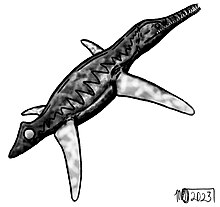
SpinoDragon145 (talk) 00:16, 28 December 2023 (UTC)
- Can't say much about their accuracy, but the signatures look a bit more prominent than what's recommended. Especially if we want to use them in cladograms and such. FunkMonk (talk) 02:15, 28 December 2023 (UTC)
- I realise it's likely stylistic but it really looks like Unktaheela has a gaping fenestra. The flippers generally look a bit strange on all three, as if the bony portion is tiny and the soft tissue extensions are massive; maybe it's an issue with the linework. Also, this creates the impression that the foreflippers are flexing to an unrealistic extent.
Finally, see my earlier comment about tail flukes.Lythronaxargestes (talk | contribs) 02:40, 28 December 2023 (UTC) - The teeth appear to have been painted with simple strokes, which neglects their anatomy. The teeth of polycotylids must be narrow and relatively small, and they cannot be painted with such thick strokes. Also, in the Unktaheela drawing, the teeth are positioned too high on the upper jaw. HFoxii (talk) 07:36, 1 January 2024 (UTC)
- The caudal fins seem to involve almost the entirety of the tails; however, I'm not sure how plausible this is given that xenopsarian pygostyles are usually pretty small, which would seem to suggest much smaller tail fins. --Slate Weasel [Talk - Contribs] 17:31, 4 January 2024 (UTC)
Cousteauvia and Saidomys


I was doing a routine check on the bird templates and I stumbled upon this illustration, which is admittedly on an extremely obscure genera, Cousteauvia. Digging a bit, I found another piece of paleoart by the same author representing Saidomys afarensis. Both of them are on articles currently, so it might be good to have some opinions on them. Larrayal (talk) 23:37, 5 January 2024 (UTC)
- I think it goes without saying that they are quite...rough? I know we try not to exclude artwork based on artistic talent or software used, but I'm not sure these are usable. -SlvrHwk (talk) 00:06, 6 January 2024 (UTC)
Perleidus altolepis
Hello everyone. May I ask for another review of my paleoart? This time I tried to reconstruct Perleidus specifically P. altolepis. I am aware that the page already contain rough restoration of the genus and someone already tried to made life reconstruction before. But I want to try a newer version that I hope match more closely to the "half" reconstruction that is available on Perleidus page right now. So as usual, is my image good enough to be uploaded? Thanks in advance and sorry if my image still looks amateurish with those black and white pen stroke..

DD (talk) 14:17, 9 January 2024 (UTC)
- @Daeng Dino: It looks pretty nice. Btw, the other "Perleidus" life restoration on Commons actually seems to depict Redfieldius, which explains the different proportions. —Trilletrollet [ Talk | Contribs ] 16:32, 9 January 2024 (UTC)
Quebecius

Hello again. Sorry to bother everyone again, but can I have another review for my image again? I have made another reconstruction of a prehistoric fish which is Quebecius. My reference is mainly from here https://cdnsciencepub.com/doi/10.1139/e87-221 (please use Sci-Hub to opened it properly). As always, may I ask if my paleoart good enough to be uploaded for Quebecius page? Thank you in advance..
DD (talk) 14:19, 13 January 2024 (UTC)
- There is another reconstruction in this file[27] by the way. Ta-tea-two-te-to (talk) 05:28, 14 January 2024 (UTC)
Langobardisaurus


This was already reviewed and revised on discord, but I thought I would add it here for the sake of completeness. @Seismicshrimp: are you planning to upload the rest of the images you showed off on Discord (Like Protorosaurus)? Hemiauchenia (talk) 13:55, 16 January 2024 (UTC)
- The Lazarussuchus was already uploaded, fair enough. As Wikipedia's resident choristodere expert I suppose, it looks good enough to me. I mean, one could nitpick the shape of the crenellated spines on the tail see [28], but that's pretty subtle honestly. Hemiauchenia (talk) 13:57, 16 January 2024 (UTC)
- Does the size of the eye account for a possible sclerotic ring? Considering they are probably plesiomorphic for archosauromorphs. Lythronaxargestes (talk | contribs) 15:30, 17 January 2024 (UTC)
- The orbits of Langobardisaurus are pretty large [29], so they look reasonable to me even when taking into account a sclerotic ring. Hemiauchenia (talk) 18:28, 17 January 2024 (UTC)
Mambachiton
Hello all. May I ask to review another of my reconstruction? This time i tried to restore Mambachiton for the Mambachiton page. I am mostly basing the body proportion from Teleocrater skeletal reconstruction [30] and Mambachiton silhoutte from here [31]. For the osteoderm, I tried my best to follow the number of osteoderm that is mentioned in the paper of the Mambachiton first description [32] For the rest of the body, I am sorry to say that it is mostly conjectural restoration for the number and size of osteoderms..
As always, can I ask if my restoration is good enough to be uploaded? Thank you in advance...

DD (talk) 00:49, 19 January 2024 (UTC)
- The left forelimb looks mildly pronated to me. Perhaps it would be a good idea to rotate the hand outwards if possible? Lythronaxargestes (talk | contribs) 18:35, 19 January 2024 (UTC)

Livyatan Melvillei model
I made this sculpture in supervision of Dick Mol and Klaas Post. This sculpture is also used as an illustration in Klaas Post book: De fossiele zoogdieren van Nederland. Jaaproosart (talk) 17:39, 21 January 2024 (UTC)
- Going off of the revised reconstruction in Lambert et al. (2016), I don't see any major anatomical issues. Lythronaxargestes (talk | contribs) 03:38, 22 January 2024 (UTC)
- Maybe Dunkleosteus77, who wrote the Livyatan FAC, has observations. FunkMonk (talk) 09:52, 22 January 2024 (UTC)
Azendohsaurus
Hello all. Can I have another review for another Triassic reptile? This time it is a Azendosaurus specifically A. madagaskarensis which is known better than the holotype species. I mainly used skeletal reconstruction from [33] and most of Shringasaurus reconstructions like the one that Nobu Tamura made on Azendohsaurus page. So, as always, is my image good enough to be uploaded? Thank you in advance...

DD (talk) 13:04, 25 January 2024 (UTC)
- Comparing the overall form of the skull, the mandible should be deeper than it is right now, and the (diagnostic) ventral deflection at its tip is not present. Lythronaxargestes (talk | contribs) 13:45, 25 January 2024 (UTC)
- Ah I see. I will have to fix that then.. But how about the body? Is it passable? DD (talk) 03:18, 26 January 2024 (UTC)
- I don't see major issues there, but DrawingDinosaurs may have further comments. Lythronaxargestes (talk | contribs) 17:15, 26 January 2024 (UTC)
- I think that the skull is too low and the eye is shifted too far back. Skull reconstructions and fossil material for this species present a tall, narrow skull with a very blunt snout tip. In its current condition it reminds me of Plateosaurus, which had a much longer snout than Azendohsaurus. The head also looks a bit small, it would be good to double-check the scaling. One last thing: though the body looks fine enough at a glance, it may be worth beefing up the limbs a bit. I'd be careful with using NT's Shringasaurus as a good model, since that reconstruction has a strangely puny upper arm. Probably because the skeletal is in a weird sprawling posture which doesn't fully depict the true size of the humerus. NGPezz (talk) 03:09, 27 January 2024 (UTC)
- I don't see major issues there, but DrawingDinosaurs may have further comments. Lythronaxargestes (talk | contribs) 17:15, 26 January 2024 (UTC)
- Ah I see. I will have to fix that then.. But how about the body? Is it passable? DD (talk) 03:18, 26 January 2024 (UTC)
Cricodon
Hello all. May I ask for another review of my image? This time I have reconstructed Cricodon specifically C. kannemeyeri. I mainly used this sketch as a reference [34] and its close relatives such as Diademodon and Exaeretodon. I made the front limbs kind of sprawl since from what I have seen, the skeletal image of gomphodonts usually show their leg to be oriented outward a little? Thank you in advance as always..

DD (talk) 05:59, 31 January 2024 (UTC)
- @Daeng Dino: Yes, the forelimbs would have been semi-sprawling. Fully erect forelimbs probably first appeared in therian mammals and their closest relatives.
- The image looks pretty good as usual, and I don't see any major problems with it. —Trilletrollet [ Talk | Contribs ] 13:00, 31 January 2024 (UTC)
Hominin diagram dump
I spent the morning making images for hominin fossils that needed them.
-
Abel
-
Simon
-
Misliya-1
-
KNM-TH 13150
-
Bontnewydd
-
KNM-ER 64060
Clumsystiggy (talk) 18:33, 27 January 2024 (UTC)
- It would be helpful to label anatomical terms of orientation somewhere for each of the views that you show. Lythronaxargestes (talk | contribs) 04:30, 28 January 2024 (UTC)
- Would updating their descriptions do the trick? Clumsystiggy (talk) 04:57, 28 January 2024 (UTC)
- At least that, I'd say. Lythronaxargestes (talk | contribs) 22:53, 28 January 2024 (UTC)
- Some of the teeth look really simplified. Since teeth are so diagnostic in mammals, wouldn't it be better to present the divisions between different cusps with more clarity? NGPezz (talk) 00:36, 29 January 2024 (UTC)
- Sorry for such a long wait, the diagrams showing teeth now have cusp/fold/pitting details and their descriptions are updated as well. Clumsystiggy (talk) 17:36, 1 February 2024 (UTC)
- Some of the teeth look really simplified. Since teeth are so diagnostic in mammals, wouldn't it be better to present the divisions between different cusps with more clarity? NGPezz (talk) 00:36, 29 January 2024 (UTC)
- At least that, I'd say. Lythronaxargestes (talk | contribs) 22:53, 28 January 2024 (UTC)
- Would updating their descriptions do the trick? Clumsystiggy (talk) 04:57, 28 January 2024 (UTC)

Hello. Here is a reconstruction of Kodymirus vagans. I believe it is more morphologically accurate than the current reconstruction on the page, but I think it would be good to have both. PaleoEquii (talk) 10:22, 12 February 2024 (UTC)
- It looks good! The morphology of the raptorial appendages is a better match for the morphology illustrated by Lamsdell et al. 2013 than the image currently on the page, for the most part, although you do appear to have the terminal article of the appendage somewhat longer than Lamsdell et al. show it. I am also a bit concerned that the image is a bit difficult to interpret at thumbnail size, due to the murky palette and water effects, but that's a fairly minor concern, especially if it's not going to be the only illustration on the page. I would encourage you to double-check the appendage proportions, but other than that, if nobody else has any comments, I think it's good to go. Ornithopsis (talk) 00:08, 13 February 2024 (UTC)
- Thank you. I've made the requested change to the frontal appendages. PaleoEquii (talk) 02:17, 14 February 2024 (UTC)
- What do you think @Junnn11 since you are recently working on artiopod pages? Ta-tea-two-te-to (talk) 02:20, 14 February 2024 (UTC)
- In my opinion, the left antenna seems to be a bit too far away. Based on MR65789, the attachment points located just between the hypostome and lateral eyes, thus I'll suspect it was a bit more closer to the right antenna, or just below the anterior margin of the left eye in this image.
- But this could be just an angle issue, suspecting the invisible proximal section was curved mesially to the hypostome beneth the carapace. Anyway just minor detail, I think It is very good for an ecological reconstruction, especially showing how it make contact with the substrate as suggested by Lamsdell et al. 2013. Junnn11 (talk) 03:34, 14 February 2024 (UTC)
- Another one is about the caption (sorry if It's a bit off topic).
- As far as I know despite of its phylogenetic position, this genus is at best considered to be a close relative (aglaspidid-like arthropod) instead of a member of aglaspidid, not to mention lots of its features (e.g. kidney-shaped eyes; specialized post-oral appendages; 13 trunk segments) didn't match the current diagnosis of Aglaspidida (Lerosey-Aubril et al. 2017). Junnn11 (talk) 03:51, 14 February 2024 (UTC)
- I think the antenna is where it needs to be - in the 3D model its origin is level with the eyes, just slightly more messial / closer to the axis of the body.
- As for the phylogenetic placement, I agree, I shouldn't have been so brief. I support changing it to reflect the more ambiguous, stem-ward placement. PaleoEquii (talk) 04:36, 14 February 2024 (UTC)
Palaeophis size chart?

This is chart that is used in Titanoboa and Gigantophis article, but it looks like Palaeophis is recently added. I would say that body shape would be too speculative? Ta-tea-two-te-to (talk) 04:12, 14 February 2024 (UTC)
- Have you checked the source listed? Maybe the reasoning for the body shape can be found there. The Morrison Man (talk) 16:20, 14 February 2024 (UTC)
- It looks like just referring this paper.[35] Ta-tea-two-te-to (talk) 16:34, 14 February 2024 (UTC)
- Ok so it looks like P. colossaeus is actually the most primitive species of Palaeophis. That probably means the body shape is too speculative and most likely also unsupported. The Morrison Man (talk) 16:51, 14 February 2024 (UTC)
- It looks like just referring this paper.[35] Ta-tea-two-te-to (talk) 16:34, 14 February 2024 (UTC)
Saccorhytus revisited
-
Saccorhytus as it may have been seen under a microscope.
-
Plain reconstruction of Saccorhytus.
Hello. I made a reconstruction of Saccorhytus as an Ecdysozoan, as it very likely was. I made two images with the model, one as it may have looked under a microscope, and one plain with a transparent background. Considering all but one reconstruction available shows it inaccurately as a deuterostome, and the only ecdysozoan reconstruction is barely 54 KBs, I think we could use both of these reconstructions on the page, along with one of the existing deuterostome reconstructions for comparison. Also, while I'm here, I think the page itself could use a cleanup regarding its ecdysozoan nature. PaleoEquii (talk) 00:14, 16 February 2024 (UTC)
- As I see it is fine to me, better than other reconstructions in Commons. Ta-tea-two-te-to (talk) 06:48, 16 February 2024 (UTC)
-
Reconstruction according with Liu et al. 2022
-
First reconstruction by Nobu Tamura
I noticed that @Christelle masclef: have tweaked reconstruction by Nobu Tamura without review. Original one is outdated and new one is after revision by Liu et al. 2022,[36] but is this tweak fine? Ta-tea-two-te-to (talk) 12:49, 1 January 2024 (UTC)
- I think it is fine, but I don't like how grainy it looks, also the small size of the image means you can't zoom in that much to see more details. Fossiladder13 (talk) 21:05, 1 January 2024 (UTC)
- Hi! Have you seen images of the fossils themselves? They do not allow further details. Nobu Tamura, and i following him, did what we could. Without a microscopic observation of a living Saccorhytus, we will never know what it really looked like. --Christelle masclef (talk) 09:30, 17 February 2024 (UTC)
Mullerornis & Pachystruthio


Hello. I wanted to upload these two restorations of Pachystruthio dmanisensis and Mullerornis modestus for review before uploading and adding them to their respective pages. I find that these two taxa are very lacking in up-to-date, accurate artistic representation. Pagodroma721 (talk) 19:52, 14 February 2024 (UTC)
- The Mullerornis looks off-balance? Like it would tip backwards. FunkMonk (talk) 08:25, 15 February 2024 (UTC)
- Agreed, though it might be due to the feathering at the back of the body? Pachystruthio looks very nice, though I must admit I'm not too familiar with it. The Morrison Man (talk) 13:53, 15 February 2024 (UTC)
- Would be useful to have a human silhouette for scale in the Pachystruthio image, as its large size is what primarily disinguishes it from Struthio. Hemiauchenia (talk) 01:05, 16 February 2024 (UTC)
- It has been argued in the past that it is preferrable to keep life restorations and size charts separate (not necessarily to say that shouldn't be the case here). Unfortunately, in its current state, the article is not really large enough to hold two images. -SlvrHwk (talk) 04:10, 16 February 2024 (UTC)
- I don't think combining restorations with size estimates is generally a good idea, because size estimates are very fluid, and once the scale human becomes inaccurate after some new study, the restoration is removed along with it, as has often been the case. Keeping them separate solves this recurring problem. FunkMonk (talk) 09:59, 17 February 2024 (UTC)
- It has been argued in the past that it is preferrable to keep life restorations and size charts separate (not necessarily to say that shouldn't be the case here). Unfortunately, in its current state, the article is not really large enough to hold two images. -SlvrHwk (talk) 04:10, 16 February 2024 (UTC)
Artwork review User:YellowPanda2001
Hi, I have a few artworks made by me, for animal pages that belong to the Posidonia Shale. I'd like to see how well they would fit for review, before I could add them to pages.
YellowPanda2001 (talk) 19:57, 1 February 2024 (UTC)
- I would say Trachymetopon may need more meats on its tail, compare to reconstruction in this paper (you can see image search probably).[37] Ta-tea-two-te-to (talk) 09:59, 2 February 2024 (UTC)
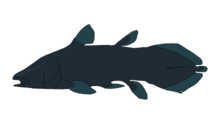
Trachymetopon life restoration - I've made the required adjustement on Trachymetopon. I hope its more presentable this way. YellowPanda2001 (talk) 14:05, 9 February 2024 (UTC)
- Slate Weasel may have comments on the ichthyosaur? Lythronaxargestes (talk | contribs) 14:38, 9 February 2024 (UTC)
- I'd recommend adding a caudal keel, and the outline of the animal could be smoothed out in regions where it's currently rather bumpy; I don't know enough about Magnipterygius to provide a more detailed review. --Slate Weasel [Talk - Contribs] 18:23, 10 February 2024 (UTC)

Magnipterygius life restoration - Here's an updated version of Magnipterygius with the suggested changes. Hopefully its better now. YellowPanda2001 (talk) 10:36, 17 February 2024 (UTC)
- I'd recommend adding a caudal keel, and the outline of the animal could be smoothed out in regions where it's currently rather bumpy; I don't know enough about Magnipterygius to provide a more detailed review. --Slate Weasel [Talk - Contribs] 18:23, 10 February 2024 (UTC)
Thalattoarchon pictures
Hello, if you have followed my activities with my contributions, you know that my article on the apex predatory ichthyosaur Thalattoarchon is currently awaiting review for the GA. However, during my writing of this article, I transferred two images from the article by Frobisch et al., 2013. As this article is free to access and I found no laws prohibiting the I used these images, I then integrated them into the article. However, during my peer review with Slate Weasel, the latter advises me to delete them due to the fact that it was potentially not free of rights. As I am lost with these regulations, what is your opinion on these two images, should I delete them or keep them? Amirani1746 (talk) 18:55, 18 February 2024 (UTC)
- First off, this is not the purpose of this page; these kind of issues are better discussed at talk pages. But I agree with Slate Weasel's comments. Since there is no indication of a free license on the relevant publication (explained more in-depth on the journal's "license terms" page), the images should probably be deleted. -SlvrHwk (talk) 19:13, 18 February 2024 (UTC)
Ekaltadeta
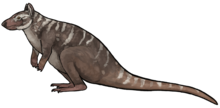
Material referenced from "The Skull of Ekaltadeta ima (Marsupialia, Hypsiprymnodontidae?): An Analysis of Some Marsupial Cranial Features and a Re-Investigation of Propleopine Phylogeny, with Notes on the Inference of Carnivory in Mammals"
Reconstruction mostly based on living macropods including its closest living relative hypsiprymnodon moschatus which has similar incisor sizes proportionally. SeismicShrimp (talk) 03:28, 18 February 2024 (UTC)
- Did you take into account the lower jaw material [38]? It seems to be deeper than you have it here. Lythronaxargestes (talk | contribs) 15:16, 22 February 2024 (UTC)
- i did in the original sketch but it seems like something happened when i was doing lineart so it got messed up. Should be able to update it with the correct depth in a few minutes SeismicShrimp (talk) 17:01, 22 February 2024 (UTC)
- it's fixed SeismicShrimp (talk) 17:09, 22 February 2024 (UTC)
Various reconstructions
hi!! i finished these guys a bit ago and was wondering if they looked alright to use on their respective articles; im most concerned about the Sulestes as i feel it may be too speculative for use here based on what we know of it/its relatives but i am really not sure. any feedback appreciated :)
-
Sulestes
-
Kraglievichia
-
Milosaurus
-
Hainina
-
Bashuchelys
-
Leninia
Raingerr (talk) 06:31, 21 February 2024 (UTC)
- I think the osteoderms on Kraglievichia could be a bit more extensive on the forehead (see Holmesina for that matter). Also, I don't know if neck osteoderms are a thing in pampatheres... Larrayal (talk) 12:23, 22 February 2024 (UTC)
- The caudal keel of Leninia could be emphasised. Is there a reason why it's reconstructed as being so longirostrine compared to other ophthalmosaurines when it's only known from the back of the skull? Lythronaxargestes (talk | contribs) 15:24, 22 February 2024 (UTC)
A few restorations
Protorosaurus, Araeoscelis, and Mesoleptos
SeismicShrimp (talk) 16:21, 19 February 2024 (UTC)
- Any particular reason why the limbs of Mesoleptos seem a lot more robust than restored here [39] ? Lythronaxargestes (talk | contribs) 15:28, 22 February 2024 (UTC)
- I fixed Araeoscelis (also realized the neck was slightly too long so I fixed that as well). For Mesopetos, however, in the specimen that does have a figure, there is only a humerus but even with that, I felt that the authors may have not added enough soft tissue. Though not a perfect analog, I based the amount of muscle off of x-ray images of varanids. It's sort of a tough situation since the holotype and the other more complete specimen were both lost so it's a bit tricky to know how close the illustration actually is to the material. If needed, I can edit the limbs but I believe that given what i could find in the literature, they are within reason. SeismicShrimp (talk) 17:34, 22 February 2024 (UTC)
- OK, fair enough. Lythronaxargestes (talk | contribs) 19:01, 22 February 2024 (UTC)
- Anything else to fix with my Araeoscelis restoration or am I good to update all three of these? SeismicShrimp (talk) 20:01, 22 February 2024 (UTC)
- I think they're fine. Lythronaxargestes (talk | contribs) 12:50, 23 February 2024 (UTC)
- Anything else to fix with my Araeoscelis restoration or am I good to update all three of these? SeismicShrimp (talk) 20:01, 22 February 2024 (UTC)
- OK, fair enough. Lythronaxargestes (talk | contribs) 19:01, 22 February 2024 (UTC)
- I fixed Araeoscelis (also realized the neck was slightly too long so I fixed that as well). For Mesopetos, however, in the specimen that does have a figure, there is only a humerus but even with that, I felt that the authors may have not added enough soft tissue. Though not a perfect analog, I based the amount of muscle off of x-ray images of varanids. It's sort of a tough situation since the holotype and the other more complete specimen were both lost so it's a bit tricky to know how close the illustration actually is to the material. If needed, I can edit the limbs but I believe that given what i could find in the literature, they are within reason. SeismicShrimp (talk) 17:34, 22 February 2024 (UTC)
- Meanwhile the head of Araeoscelis seems a little too small compared to how Reisz et al. [40] restored it. Lythronaxargestes (talk | contribs) 15:35, 22 February 2024 (UTC)
- The Protorosaurus looks fine as it was previously reviewed by NGPezz on discord. Hemiauchenia (talk) 19:05, 22 February 2024 (UTC)
Parexus sp. Restoration

Based on reconstruction from "Redescription of Parexus recurvus, an Early Devonian acanthodian from the Midland Valley of Scotland" SeismicShrimp (talk) 04:25, 24 February 2024 (UTC)
Lichas marocanus

Hi, this is my first submission, I made this restoration of Lichas marocanus trilobite in Blender based on my own finds, other fossils available publically and articles about related species, I'm not an expert in this field and sometimes I may unknowingly add some speculative elements so I doubt that this restoration could be viewed as accurate, at least i'll know what to improve in the future. Wawrow (talk) 22:27, 18 February 2024 (UTC)
- I'm not an expert of trilobite either, but I have some questions about the legs.
- One is the distinct width between the distal endopod segments with fused terminal claw. Is there any published evidence for this feature? As much as I known, the width (excluding the ventral spines) of trilobite endopod gradually decrease towards the distal end, and the trifurcated distal claw itself is a tiny, distinct segment.
- Another one is the exopod. It might be an angle issue, but it reminds me of the outdated spiral-shaped reconstruction, or perhaps it was tend to be multisegmented like those of Triarthrus? I don't know if any Lichida appendages had been discovered after early 2000s (not yet at that time), but In the Bohemolichas paper, the exopod (although very faint) was reconstructed as bilobed flap, typical for trilobites. Junnn11 (talk) 07:43, 22 February 2024 (UTC)


























